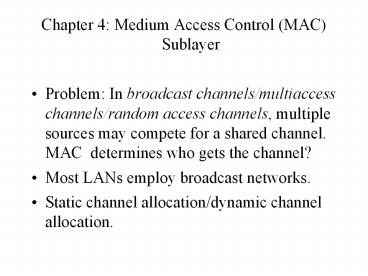Chapter 4: Medium Access Control (MAC) Sublayer PowerPoint PPT Presentation
Title: Chapter 4: Medium Access Control (MAC) Sublayer
1
- Chapter 4 Medium Access Control (MAC) Sublayer
- Problem In broadcast channels/multiaccess
channels/random access channels, multiple sources
may compete for a shared channel. MAC determines
who gets the channel? - Most LANs employ broadcast networks.
- Static channel allocation/dynamic channel
allocation.
2
- Dynamic Multiple access protocols
- pure ALOHA
- A node transmits whenever it has data
- if conflict, wait for a random time and retry
- slotted ALOHA
- divide time into slots, one frame each slot
- send only at the time slot boundary
- math says that the maximum throughput is 2 times
higher. - less chance to collide
3
- Carrier Sense Multiple Access Protocols (CSMA)
- carrier sence listen to the carrier and act
accordingly. - persistent / non-persistent / p-persistent CSMA
- persistent CSMA
- listen first, if no one there, send
- if busy, wait (keep listening) till it becomes
idle. - propagation delay is an factor that affects the
performance. - conflict even without propagation delay.
- Non-persistent CSMA
- listen first, if no one there, send
- if busy, wait random period time and repeat. (not
greedy) - p-persistent CSMA (slotted channel)
- listen fist , if idle, send with a probability p
- if busy, wait for a random time and repeat.
4
- CSMA with collision detection CSMA/CD
- improve CSMA by aborting faster when collision.
- How long do we need to detect collision (with
CSMA)? - propagation time 2
- pure ALOHA, slotted ALOHA, CSMA and CSMA/CD are
contention based protocols - try. If collide, retry.
- No guarantee of performance.
- What happens if the network load is high?
- Collision free protocols
- pay constant overhead to achieve performance
guarantee - Good when network load is high
5
- Collision free protocols
- bit-map method.
- control frame contain N bits, each station send 1
bits to indicate whether it has a frame to send - at the end of the control frame, every station
knows all the station that want to send, the
station can send in order. - example
- 0 1 2 3
0 1 2 3 - 0 1 0 1 frame 1 frame 3 1
0 0 0 frame 0 - Performance
- d/(d1) channel utilization rate for high load.
- N bits delay for low load. (d is the frame size).
6
- Collision free protocols binary countdown
- each station sends the address bits in some order
(from highest order bit to the lowest order bit).
- The bits in each position from different stations
are ORed. - As soon as a station sees that a high-order bit
position that is 0 is overwrite by 1, it gives
up. - Eventual, only one station (with largest station
number among all the competitors) gets the
channel. - example
- station 2 (0010) 0 (give up)
- station 4 (0100) 0 (give up)
- station 9 (1001) 1 0 0 (give up)
- station 10 (1010) 1 0 1 0 (finished address,
send data) - OR 1 0 1 0
- Performance
- channel utilization rate d/(dlog(N)) for high
load - log(N) bits delay for low load.
- Contention field can serve as the address field.
7
- Collision free protocols
- Token pass.
- There is only one token in the network.
- The token is passed through every node in the
network. - Only the node that has the token can transfer
data.
8
- Limited contention protocols
- collision based protocols (ALOHA,CSMA/CD) are
good when the network load is low. - collision free protocols (bit map, binary
countdown) are good when load is high. - How about combining their advantages -- limited
contention protocols. - Behave like the ALOHA scheme under light load
- Behave like the bitmap scheme under heavy load.
9
- Limited contention protocols
- adaptive tree walk protocol
- trick partition the group of station and limit
the contention for each slot. - under light load, every one can try for each slot
like aloha - under heavy load, only a small group can try for
each slot - how do we do it
- treat stations as the leaf of a binary tree.
- first slot (after successful transmission), all
stations (under the root node) can try to get the
slot. - if no conflict, fine.
- if conflict, only nodes under a subtree get to
try for the next one. (depth first search)
10
Example
0
2
1
3
6
4
5
D
A
B
C
E
F
G
H
Slot 0 C, E, F, H (all nodes under node 0
can try), conflict slot 1 C (all nodes under
node 1 can try), C sends slot 2 E, F, H(all
nodes under node 2 can try), conflict slot 3 E,
F (all nodes under node 5 can try),
conflict slot 4 E (all nodes under E can try),
E sends slot 5 F (all nodes under F can try), F
sends slot 6 H (all nodes under node 6 can
try), H sends.

